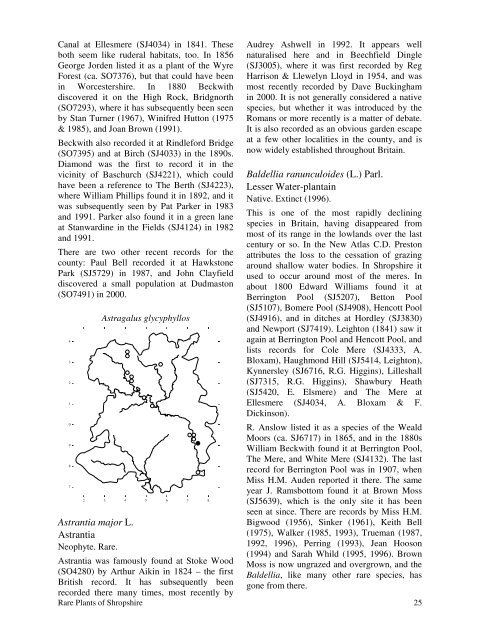Shropshire - Botanical Society of the British Isles
Shropshire - Botanical Society of the British Isles
Shropshire - Botanical Society of the British Isles
- No tags were found...
Create successful ePaper yourself
Turn your PDF publications into a flip-book with our unique Google optimized e-Paper software.
Canal at Ellesmere (SJ4034) in 1841. Theseboth seem like ruderal habitats, too. In 1856George Jorden listed it as a plant <strong>of</strong> <strong>the</strong> WyreForest (ca. SO7376), but that could have beenin Worcestershire. In 1880 Beckwithdiscovered it on <strong>the</strong> High Rock, Bridgnorth(SO7293), where it has subsequently been seenby Stan Turner (1967), Winifred Hutton (1975& 1985), and Joan Brown (1991).Beckwith also recorded it at Rindleford Bridge(SO7395) and at Birch (SJ4033) in <strong>the</strong> 1890s.Diamond was <strong>the</strong> first to record it in <strong>the</strong>vicinity <strong>of</strong> Baschurch (SJ4221), which couldhave been a reference to The Berth (SJ4223),where William Phillips found it in 1892, and itwas subsequently seen by Pat Parker in 1983and 1991. Parker also found it in a green laneat Stanwardine in <strong>the</strong> Fields (SJ4124) in 1982and 1991.There are two o<strong>the</strong>r recent records for <strong>the</strong>county: Paul Bell recorded it at HawkstonePark (SJ5729) in 1987, and John Clayfielddiscovered a small population at Dudmaston(SO7491) in 2000.43210987Astragalus glycyphyllos2 3 4 5 6 7 8Astrantia major L.AstrantiaNeophyte. Rare.Audrey Ashwell in 1992. It appears wellnaturalised here and in Beechfield Dingle(SJ3005), where it was first recorded by RegHarrison & Llewelyn Lloyd in 1954, and wasmost recently recorded by Dave Buckinghamin 2000. It is not generally considered a nativespecies, but whe<strong>the</strong>r it was introduced by <strong>the</strong>Romans or more recently is a matter <strong>of</strong> debate.It is also recorded as an obvious garden escapeat a few o<strong>the</strong>r localities in <strong>the</strong> county, and isnow widely established throughout Britain.Baldellia ranunculoides (L.) Parl.Lesser Water-plantainNative. Extinct (1996).This is one <strong>of</strong> <strong>the</strong> most rapidly decliningspecies in Britain, having disappeared frommost <strong>of</strong> its range in <strong>the</strong> lowlands over <strong>the</strong> lastcentury or so. In <strong>the</strong> New Atlas C.D. Prestonattributes <strong>the</strong> loss to <strong>the</strong> cessation <strong>of</strong> grazingaround shallow water bodies. In <strong>Shropshire</strong> itused to occur around most <strong>of</strong> <strong>the</strong> meres. Inabout 1800 Edward Williams found it atBerrington Pool (SJ5207), Betton Pool(SJ5107), Bomere Pool (SJ4908), Hencott Pool(SJ4916), and in ditches at Hordley (SJ3830)and Newport (SJ7419). Leighton (1841) saw itagain at Berrington Pool and Hencott Pool, andlists records for Cole Mere (SJ4333, A.Bloxam), Haughmond Hill (SJ5414, Leighton),Kynnersley (SJ6716, R.G. Higgins), Lilleshall(SJ7315, R.G. Higgins), Shawbury Heath(SJ5420, E. Elsmere) and The Mere atEllesmere (SJ4034, A. Bloxam & F.Dickinson).R. Anslow listed it as a species <strong>of</strong> <strong>the</strong> WealdMoors (ca. SJ6717) in 1865, and in <strong>the</strong> 1880sWilliam Beckwith found it at Berrington Pool,The Mere, and White Mere (SJ4132). The lastrecord for Berrington Pool was in 1907, whenMiss H.M. Auden reported it <strong>the</strong>re. The sameyear J. Ramsbottom found it at Brown Moss(SJ5639), which is <strong>the</strong> only site it has beenseen at since. There are records by Miss H.M.Bigwood (1956), Sinker (1961), Keith Bell(1975), Walker (1985, 1993), Trueman (1987,1992, 1996), Perring (1993), Jean Hooson(1994) and Sarah Whild (1995, 1996). BrownMoss is now ungrazed and overgrown, and <strong>the</strong>Baldellia, like many o<strong>the</strong>r rare species, hasgone from <strong>the</strong>re.Astrantia was famously found at Stoke Wood(SO4280) by Arthur Aikin in 1824 – <strong>the</strong> first<strong>British</strong> record. It has subsequently beenrecorded <strong>the</strong>re many times, most recently byRare Plants <strong>of</strong> <strong>Shropshire</strong> 25
















